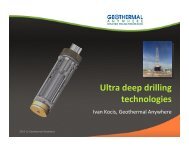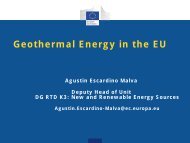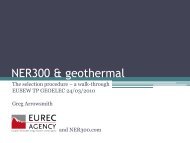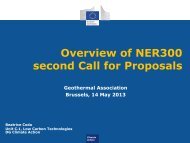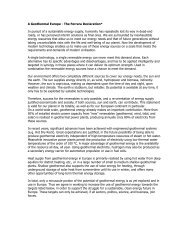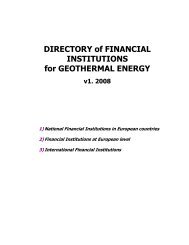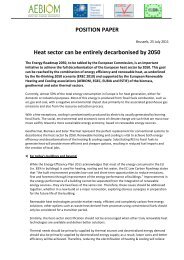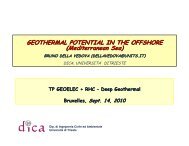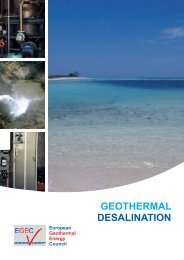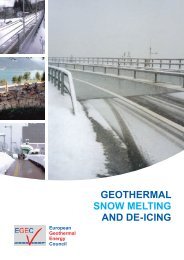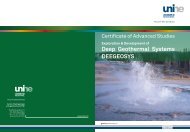Strategic Research and Innovation Agenda for Renewable ... - EGEC
Strategic Research and Innovation Agenda for Renewable ... - EGEC
Strategic Research and Innovation Agenda for Renewable ... - EGEC
You also want an ePaper? Increase the reach of your titles
YUMPU automatically turns print PDFs into web optimized ePapers that Google loves.
<strong>Renewable</strong>Heating & CoolingEuropean Technology Plat<strong>for</strong>mIn the EU, the share of heating <strong>and</strong> cooling from renewable sources has increased from 57.6Mtoe in 2004 (i.e. approximately 9.6% of total consumption) to nearly 80 Mtoe in 2010(i.e. 14.4%) (Figure 3). A linear increase in the market share is expected from 2011-2020,<strong>and</strong> <strong>for</strong> the period 2020-2030 a further market gain of 10%. This advancement is dependenton RES becoming st<strong>and</strong>ard in new energy efficient buildings in all EU countries.700600Other 1%Industry 39%Mtoe500400300200Services 14%10009.6% 9.9% 10.6% 11.8% 12.8% 13.5% 14.3%2004 2005 2006 2007 2008 2009 2010Non-renewable energy <strong>for</strong> heating <strong>and</strong> cooling<strong>Renewable</strong> energy <strong>for</strong> heating <strong>and</strong> coolingural areas)rban areas)2020 2030 2050<strong>Renewable</strong> heatHeat dem<strong>and</strong> BAUHeat dem<strong>and</strong> RDP14European Commission (EC)(2012a)15The Energy Per<strong>for</strong>mance ofBuildings Directive – EPBD(EU 2010) is currently themain 8000 EU legislative instrumentto reduce the energy consumption7000of buildings. Underthis Directive, Member Statesmust 6000 establish <strong>and</strong> applyminimum energy per<strong>for</strong>mancerequirements 5000 <strong>for</strong> new <strong>and</strong>existing buildings, ensure thecertification 4000 of building energyper<strong>for</strong>mance <strong>and</strong> require theregular 3000 inspection of boilers<strong>and</strong> air conditioning systemsin buildings. 2000 Moreover, theDirective requires MemberStates 1000 to ensure that by 2021all new buildings are so-called‘nearly 0 zero-energy buildings’.205016This trend of growing coolingdem<strong>and</strong> is particularly meaningfulin Southern Europe.In countries such as Spain,Italy <strong>and</strong> Greece the annualnumber of hours of coolingdem<strong>and</strong> already exceeds thenumber of hours of heatingdem<strong>and</strong>, especially in nonresidential8000 buildings.7000600050004000TWhTWhFigure 3 - Heating <strong>and</strong> cooling supply in the EU-27 (2004-2010) 146005002.3 From Common Vision400to <strong>Strategic</strong> <strong>Research</strong> <strong>and</strong> <strong>Innovation</strong> <strong>Agenda</strong>In May 2011 300 the RHC-Plat<strong>for</strong>m launched its first official publication: the “Common Vision <strong>for</strong>the <strong>Renewable</strong> Heating <strong>and</strong> Cooling Sector in Europe”. The study is an assessment of thepotential of 200 renewable heating <strong>and</strong> cooling technologies to contribute to the European <strong>and</strong>national energy needs <strong>and</strong> targets, <strong>and</strong> identifies major technological <strong>and</strong> RES H&C non-technologicalCommon Visionchallenges to 100the uptake of the RHC systems.RES H&C NREAPsEurostat RESHeating <strong>and</strong> 0cooling account <strong>for</strong> a significant proportion of Europe’s energy dem<strong>and</strong>.Efficiency gains are required in both residential heating <strong>and</strong> industrial processes with betteruse of thermal energy being crucial <strong>for</strong> meeting the 2020 renewable energy targets <strong>and</strong>Europe’s 2050 target of 80-95% reduction in GHG emissions. The key highlights of the CommonVision are outlined in what follows.MtoeEurostat total cons.Heat consumption NREAPsHeat Dem<strong>and</strong> BAUHeat Dem<strong>and</strong> RDPThe evolution of energy consumption <strong>for</strong> heating is expected to follow a different trendto that of cooling. As a consequence of energy efficiency measures <strong>and</strong> support schemeswhich are being implemented at EU 15 <strong>and</strong> national levels, a significant reduction of heatdem<strong>and</strong> could be realised in the coming decades. The opposite trend is expected <strong>for</strong> coolingdem<strong>and</strong>, the growth of which will be driven by increase in average temperatures due to globalwarming, the current trends in commercial building architecture <strong>and</strong> intolerance tothermal discom<strong>for</strong>t 16 .7



